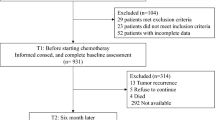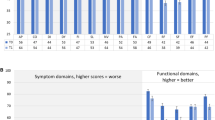Abstract
Purpose
This review compares and contrasts the development, validity, and characteristics of two quality of life (QOL) assessment tools used in patients with primary brain cancers: the European Organization for Research and Treatment of Cancer Quality of Life Questionnaire Brain Cancer Module (EORTC QLQ-BN20) and the Functional Assessment of Cancer Therapy-Brain (FACT-Br).
Methods
A literature search was conducted using the Cochrane Central Register of Controlled Trials (June 2013), Ovid EMBASE (1947 to 2013, week 27), and Ovid MEDLINE (1946 to July 2013, week 1) to identify studies that discussed the development, characteristics, validity, and reliability of the EORTC QLQ-BN20 or the FACT-Br.
Results
The EORTC QLQ-BN20 consists of 20 items that assess future uncertainty, visual disorder, motor dysfunction, and communication deficit. Items are presented as questions on a scale ranging from 1 = “not at all” to 4 = “very much.” Reliability and validity testing of the QLQ-BN20 revealed a Cronbach’s alpha coefficient that ranged from 0.71 to 0.90. The FACT-Br consists of 23 items that assess general well-being and brain cancer-specific concerns that include concentration, memory, seizures, eyesight, hearing, speech, personality, expression of thoughts, weakness, coordination, and headaches. These items are presented as statements on a scale ranging from 0 = “not applicable” to 4 = “extremely relevant.” The FACT-Br underwent validity as well as test-retest reliability testing with 101 and 46 patients, respectively. Validity testing found low to moderate correlation with the FACT-G questionnaire, while reliability testing for the brain subscale revealed an acceptable correlation coefficient (r = 0.66; p < 0.001).
Conclusions
The QLQ-BN20 and the FACT-Br are both valid and reliable tools that have been used extensively in the primary brain cancer population. Choice between the two tools should consider each instrument’s individual strengths and weaknesses.
Similar content being viewed by others
References
Jemal A, Siegel R, Xu J, Ward E (2010) Cancer statistics, 2010. CA: Cancer J Clin 60(5):277–300
Salander P (1996) Brain tumor as a threat to life and personality: the spouse’s perspective. J Psychosoc Oncol 14:1–18
Khoshnevisan A, Yekaninejad M, Ardankani S, Pakpour A, Mardani A, Aaronson N (2012) Translation and validation of the EORTC brain cancer module (EORTC QLQ-BN20) for use in Iran. Health Qual Life Outcome 10:54
Kirkbridge P, Tannock IF (2008) Trials in palliative treatment—have the goal posts been moved? Lancet Oncol 9:186–187
Kvale E, Murthy R, Taylor R, Lee J, Nabors L (2009) Distress and quality of life in primary high-grade brain tumor patients. Support Care Cancer 17(7):793–799
Stupp R, Mason WP, van den Bent MJ et al (2005) Radiotherapy plus concomitant and adjuvant temozolomide for glioblastoma. N Engl J Med 352:987–996
Brandsma D, van den Bent MJ (2007) Molecular targeted therapies and chemotherapy in malignant gliomas. Curr Opin Oncol 19(6):598–605
Popovic M, Nguyen J, Chen E, Di Giovanni J, Zeng L, Chow E (2012) Comparison of the EORTC QLQ-BM22 and the FACT-BP for assessment of quality of life in cancer patients with bone metastases. Expert Rev Pharmacoecon Outcome Res 12(2):213–219
Budrukkar A, Jalali R, Kamble R, Parab S (2006) Translation and pilot validation of Hindi translation of assessing quality of life in patients with primary brain tumours using EORTC brain module (BN-20). J Cancer Res Ther 2(4):166–170
Gotay CC (2004) Assessing cancer-related quality of life across a spectrum of applications. J. Natl Cancer Inst Monogr 33:126–133
Sneeuw KC, Aaronson NK, Osoba D et al (1997) The use of significant others as proxy raters of the quality of life of patients with brain cancer. Med Care 35(5):490–506
Aaronson NK, Ahmedzai S, Bergman B et al (1993) The European Organization for Research and Treatment of Cancer QLQ-c30: a quality-of-life instrument for use in international clinical trials in oncology. J Natl Cancer Inst 85(5):365–376
Cella DF, Tulsky DS, Gray G et al (1993) The functional assessment of cancer therapy scale: development and validation of the general measure. J Clin Oncol 11(3):570–579
Cella DF, Bonomi AE, Lloyd SR et al (1995) Reliability and validity of the Functional Assessment of Cancer Therapy-Lung (FACT-L) quality of life instrument. Lung Cancer 12(3):199–220
Steinmann D, Paelecke-Habermann Y, Geinitz H, Aschoff R, Bayeri A et al (2012) Prospective evaluation of quality of life effects in patients undergoing palliative radiotherapy for brain metastases. BMC Cancer 12:283
Osoba D, Aaronson NK, Muller M, Sneeuw K, Hsu MA, Yung WKA, Brada M, Newlands E (1996) The development and psychometric validation of a brain cancer quality-of-life questionnaire for use in combination with general cancer-specific questionnaires. Qual Life Res 5:139–150
Weitzner MA, Meyers CA, Gelke CK, Byrne KS, Cella DF, Levin VA (1995) The Functional Assessment of Cancer Therapy (FACT) scale: development of a brain subscale and revalidation of the general version (FACT-G) in patients with primary brain tumors. Cancer 75:1151–1161
Taphoorn M (2010) An international validation study of the EORTC brain cancer module (EORTC QLQ-BN20) for assessing health-related quality of life and symptoms in brain cancer patients. Eur J Cancer 46(6):1033–1040
EORTC QLC-30 – Modules. EORTC Quality of Life. http://groups.eortc.be/qol/eortc-modules. Accessed 1 August 2013
Chen E, Cella D, Liang Z et al (2012) Content validation of the FACT-Br with patients and health care professionals to assess quality of life in patients with brain metastases. J Radiat Oncol
Gazzotti MR, Alith MB, Malheiros SMF et al (2011) Functional Assessment of Cancer Therapy-Brain questionnaire: translation and linguistic adaptation to Brazilian Portuguese. Sao Paulo Med J 129(4):230–235
FACIT – Questionnaires. Facit.org. http://www.facit.org/FACITOrg/Questionnaires. Accessed 1 August 2013
Gazzotti M, Malheiros S, Alith M, Nascimento O, Santoro I, Jardim J, Vidotto M (2011) Quality of life and physical limitations in primary brain tumor patients. Qual Life Res 20(10):1639–1643
Weitzner MA, Meyers CA (1997) Cognitive functioning and quality of life in malignant glioma patients: a review of the literature. Psycho-Oncol 6:169–177
Acknowledgments
We thank the generous support of Bratty Family Fund, Michael and Karyn Goldstein Cancer Research Fund, Joseph and Silvana Melara Cancer Research Fund, and Ofelia Cancer Research Fund.
Conflict of interest
Dr. Andrew Bottomley is an author of the EORTC QLG measurement system. These tools are provided free to academics, but the EORTC charges a user fee for the use of the EORTC QLQ-C30 in industry-sponsored research in order to cover the cost of future psychometric validation, testing, and translation of HRQoL tools. Dr. David Cella is President of FACIT.org, which licenses all FACT and FACIT tools for use in international pharmaceutical clinical trials.
Author information
Authors and Affiliations
Corresponding author
Rights and permissions
About this article
Cite this article
Chow, R., Lao, N., Popovic, M. et al. Comparison of the EORTC QLQ-BN20 and the FACT-Br quality of life questionnaires for patients with primary brain cancers: a literature review. Support Care Cancer 22, 2593–2598 (2014). https://doi.org/10.1007/s00520-014-2352-7
Received:
Accepted:
Published:
Issue Date:
DOI: https://doi.org/10.1007/s00520-014-2352-7




